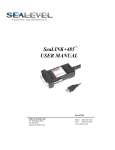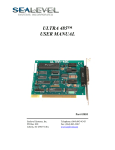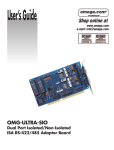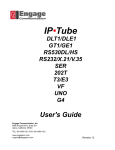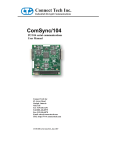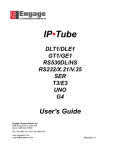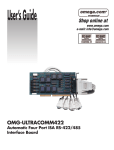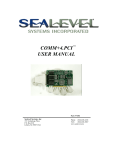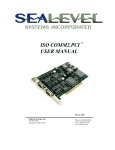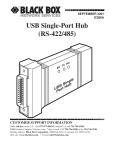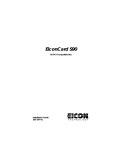Download OMG-ULTRA-485 operator`s manual
Transcript
Contents INTRODUCTION ..................................................................... 1 OVERVIEW .................................................................................. 1 WHAT’S INCLUDED ..................................................................... 1 FACTORY DEFAULT SETTINGS ..................................................... 1 CARD SETUP ......................................................................... 2 ADDRESS SELECTION .................................................................. 2 IRQ SELECTION .......................................................................... 3 INTERRUPT MODES ..................................................................... 4 RS-485 ENABLE MODES ............................................................. 5 CONNECTOR PIN ASSIGNMENTS ................................................... 7 EIA-530 .................................................................................. 7 SIO-485 .................................................................................. 8 LINE TERMINATION ..................................................................... 9 INSTALLATION .................................................................... 10 WINDOWS 3.X (INCLUDING WFW 3.11) INSTALLATION .............. 10 WINDOWS 95 AND WINDOWS NT INSTALLATION ....................... 12 OMG-ULTRA-485 SOFTWARE DRIVERS ..................................... 12 TECHNICAL DESCRIPTION .................................................. 13 FEATURES................................................................................. 13 SPECIFICATIONS ................................................................. 14 ENVIRONMENTAL SPECIFICATIONS ............................................. 14 MANUFACTURING ..................................................................... 14 POWER CONSUMPTION .............................................................. 14 MEAN TIME BETWEEN FAILURES (MTBF).................................. 14 PHYSICAL DIMENSIONS ............................................................. 14 APPENDIX A - TROUBLESHOOTING .................................... 15 APPENDIX B - HOW TO GET ASSISTANCE .......................... 17 APPENDIX C - ELECTRICAL INTERFACE ............................ 18 RS-530..................................................................................... 18 RS-422..................................................................................... 18 RS-485..................................................................................... 18 APPENDIX D - ASYNCHRONOUS COMMUNICATIONS .......... 20 APPENDIX E - SILK-SCREEN............................................... 21 APPENDIX F - COMPLIANCE NOTICES ................................ 22 FEDERAL COMMUNICATIONS COMMISSION STATEMENT .............. 22 EMC DIRECTIVE STATEMENT.................................................... 22 WARRANTY ......................................................................... 23 Figures Figure 1 - Header E1, IRQ Selection ....................................................3 Figure 2 - Header E2, Normal IRQ Mode ............................................4 Figure 3 - Header E2, Shared IRQ Mode .............................................4 Figure 4 - Header E5 RS-485 Transmit Mode ......................................5 Figure 5 - Header E3 RS-485 Receive Mode.........................................6 Figure 6 - Dip-shunt E4 (EIA-530 Mode)..............................................7 Figure 7 - Dip-shunt E4 (SIO-485 Mode) ..............................................8 Figure 8 – SW2, Line Termination........................................................9 Figure 9 - Asynchronous Communications Bit Diagram .................... 20 © 1997b Omega Engineering, Incorporated. All rights reserved. Introduction Introduction Overview The Omega Engineering OMG-Ultra-485 provides the PC with an additional RS-422/485 serial port for terminals, modems, printers, etc What’s Included The OMG-Ultra-485 is shipped with the following items. If any of these items are missing or damaged, contact the supplier. • • • OMG-Ultra-485 Serial I/O Adapter 3.5″ Serial Utility Diskette User Manual Factory Default Settings The OMG-Ultra-485 factory default settings are as follows: Port # Port 1 Base Address 3F8 IRQ 4 Electrical Specification RS-485 ‘Auto’ To install the OMG-Ultra-485 using factory default settings, refer to Installation on page 10. For your reference, record installed OMG-Ultra-485 settings below: Port # Base Address IRQ Omega Engineering OMG-Ultra-485 Electrical Specification Page 1 Card Setup Card Setup The OMG-Ultra-485 contains several jumper straps which must be set for proper operation. Address Selection The OMG-Ultra-485 occupies 8 consecutive I/O locations, and looks to the PC as a standard serial port. A DIP-switch (SW1) is used to set the port address options for the OMG-Ultra-485. Be careful when selecting the port addresses as some selections may conflict with existing ports. The following table shows the addressing options available with the standard PAL. If different address options are required, please contact Omega Engineering Technical Support about a custom PAL option. Port1 J2 Disabled 3F8 2F8 3E8 2E8 3220 3228 4220 4228 238 300 308 280 288 290 298 SW1-1 On On On On On On On On Off Off Off Off Off Off Off Off SW1-2 On On On On Off Off Off Off On On On On Off Off Off Off SW1-3 On On Off Off On On Off Off On On Off Off On On Off Off SW1-4 On Off On Off On Off On Off On Off On Off On Off On Off Note: Each COM port in the system should have a unique address. Typically COM1: - COM4: addresses are 3F8, 2F8, 3E8 & 2E8 Hex. Omega Engineering OMG-Ultra-485 Page 2 Card Setup IRQ Selection Header E1 selects the interrupt request for each serial port. If COM1: is selected, the corresponding jumper must be on the IRQ4 setting. If COM2: is selected, the corresponding jumper must be on IRQ3. Note: Most communications software applications default COM3: to IRQ4 and COM4: to IRQ3. This requires the sharing of interrupts between COM1: and COM3:, and between COM2: and COM4:. While this is the default, it is not always the preferred setting. Check your software configuration instructions to determine the most appropriate IRQ selection. E1 2 3 4 5 7 10 11 12 15 Figure 1 - Header E1, IRQ Selection Any two or more ports can share a common IRQ by placing the jumpers on the same IRQ setting at header E1 and setting the appropriate selections at E2. Consult your particular software for IRQ selection. If no interrupt is desired, remove the jumper. Omega Engineering OMG-Ultra-485 Page 3 Card Setup Interrupt Modes Header E2 selects the interrupt mode for the OMG-Ultra-485. ‘N’ indicates the (N)ormal, single interrupt per port mode. ‘S’ Indicates the (S)hared interrupt mode, which allows more than one port to access a single IRQ. Any two or more ports can share a common IRQ by placing the jumpers on the same IRQ setting and setting the appropriate selections at E1. Consult your particular software for IRQ selection. If no interrupt is desired, remove the jumper. ‘M’ indicates the inclusion of a 1K ohm pulldown resistor required on one port when sharing interrupts. Figure 2 - Header E2, Normal IRQ Mode Set the jumper to ‘S’ if you are using more than one OMG-Ultra-485 in a bus or to completely remove the pull-down resistor for hardware compatibility. Setting the adapter in this configuration when it is not accompanied by a pull-down resistor will prevent the ports from triggering an interrupt. Set the jumpers to ‘S’ for shared interrupt mode on all blocks sharing an IRQ except one. Set that port block for ‘M’. This provides the pull-down resistor circuit that makes sharing IRQs possible. If you are using more than one OMG-Ultra-485 or a compatible adapter in a bus you should only have one port set to ‘M’. The following example shows two OMGUltra-485 adapters sharing a single IRQ. Figure 3 - Header E2, Shared IRQ Mode Omega Engineering OMG-Ultra-485 Page 4 Card Setup RS-485 Enable Modes RS-485 is ideal for multi-drop or network environments. RS-485 requires a tri-state driver (not dual-state) that will allow the electrical presence of the driver to be removed from the line. The driver is in a tri-state or high impedance condition when this occurs. Only one driver may be active at a time and the other driver(s) must be tri-stated. The output modem control signal Request To Send (RTS) is typically used to control the state of the driver. Some communication software packages refer to RS-485 as RTS enable or RTS block mode transfer. One of the unique features of the OMG-Ultra-485 is the ability to be RS485 compatible without the need for special software or drivers. This ability is especially useful in Windows, Windows NT, and OS/2 environments where the lower level I/O control is abstracted from the application program. This ability means that the user can effectively use the OMG-Ultra-485 in a RS-485 application with existing (i.e. standard RS-232) software drivers. Header E5 is used to control the RS-485 mode functions for the transmitter circuit. The selections are ‘RTS’ enable, ‘Auto’ enable, or ‘422’ which means always enabled. The ‘Auto’ enable feature automatically enables/disables the RS-485 transmitter circuit. The ‘RTS’ mode uses the ‘RTS’ modem control signal to enable the RS-485 transmitter circuit and provides backward compatibility with existing software products. The ‘422’ mode allows the port to be used in a point to point RS-422 application where the tri-stating of the transmitter circuit is not required. E5 AUTO RTS 422 TX AUTO RTS 422 Driver automatically enabled/disabled Driver enabled by UART RTS signal Driver always enabled Note: The jumper in the above example is in the ‘422’ position. This is the only setting in which the modem control outputs (RTS, DTR) are valid. Omega Engineering OMG-Ultra-485 Page 5 Card Setup Figure 4 - Header E5 RS-485 Transmit Mode Header E3 is used to control the RS-485 enable/disable functions for the receiver circuit. The RS-485 ‘Echo’ is the result of connecting the receiver inputs to the transmitter outputs. Every time a character is transmitted, it is also received. This can be beneficial if the software can handle echoing (i.e. using received characters to throttle the transmitter) or it can confuse the system if the software does not. The selection at E3 should follow the selection made at E5 if ‘No Echo’ is desired. If Echo suppression is not desired then leave the jumper in the ‘422’ position. Also note, the modem control inputs (DSR, DCD, CTS) are only valid when Header E3 is in the 422 mode. These header blocks are described in the illustration and table that follow. E3 AUTO RTS 422 RX AUTO RTS 422 Receiver automatically enabled/disabled Receiver enabled by UART RTS signal Receiver always enabled Figure 5 - Header E3 RS-485 Receive Mode Omega Engineering OMG-Ultra-485 Page 6 Card Setup Connector Pin Assignments EIA-530 DIP-shunt E4 selects the pin out for the DB-25 connector P3. With the 5 position shunt in the EIA-530 mode, the ULTRA-485 complies with the EIA-530 pin out with the following signals supported: E4 SIO-485 EIA-530 Figure 6 - Dip-shunt E4 (EIA-530 Mode) Signal GND RDB RDA CTSB CTSA DSRB DSRA DCDB DCDA TDB TDA RTSB RTSA DTRB DTRA RX+ RXCTS+ CTSDSR+ DSRDCD+ DCDTX+ TXRTS+ RTSDTR+ DTR- Name Ground Receive Positive Receive Negative Clear To Send Positive Clear To Send Negative Data Set Ready Positive Data Set Ready Negative Data Carrier Detect Positive Data Carrier Detect Negative Transmit Positive Transmit Negative Request To Send Positive Request To Send Negative Data Terminal. Ready Positive Data Terminal Ready Negative Omega Engineering OMG-Ultra-485 Pin # 7 16 3 13 5 22 6 10 8 14 2 19 4 23 20 Mode Input Input Input Input Input Input Input Input Output Output Output Output Output Output Page 7 Card Setup SIO-485 With the 5 position shunt in the SIO-485 mode, the OMG-Ultra-485 is compatible with the Omega Engineering SIO-485 (part# 3054) with the following signals supported: E4 EIA-530 SIO-485 Figure 7 - Dip-shunt E4 (SIO-485 Mode) Signal GND TDB TDA RDB RDA / TX+ TXRX+ RX- Name Ground Transmit Positive Transmit Negative Receive Positive Receive Negative Omega Engineering OMG-Ultra-485 Pin # 7 24 25 12 13 Mode Output Output Input Input Page 8 Card Setup Line Termination Typically, each end of the RS-485 bus must have line terminating resistors (RS-422 terminates at the receive end only). A 100 ohm resistor is across each RS-530/422/485 input in addition to a 1K ohm pull-up/pull-down combination that bias the receiver inputs. DIP-switch SW2 provides the ability to customize this interface to system requirements. Each switch position corresponds to a specific portion of the interface. If multiple OMG-Ultra-485 adapters are configured in a RS-485 network, only the boards on each end should have switches T, P & P ON. Refer to the following table for each position’s operation: Name T P P L L Function Adds or removes the 120 ohm termination. Adds or removes the 1K ohm pull-down resistor in the RS-422/RS-485 receiver circuit (Receive data only). Adds or removes the 1K ohm pull-up resistor in the RS-422/RS-485 receiver circuit (Receive data only). Connects the TX+ to RX+ for RS-485 two wire operation. Connects the TX- to RX- for RS-485 two wire operation. ON OFF 1 2 3 4 5 TPPLL Figure 8 – SW2, Line Termination Omega Engineering OMG-Ultra-485 Page 9 Installation Installation The OMG-Ultra-485 can be installed in any of the PC expansion slots. The OMG-Ultra-485 contains several jumper straps for each port which must be set for proper operation. 1. 2. 3. 4. 5. 6. 7. Turn off PC power. Disconnect the power cord. Remove the PC case cover. Locate an available slot and remove the blank metal slot cover. Gently insert the OMG-Ultra-485 into the slot. Make sure that the adapter is seated properly. Replace the screw. Replace the cover. Connect the power cord. Installation is complete. Windows 3.x (Including WFW 3.11) Installation To configure the OMG-Ultra-485 under Windows 3.x start by opening the ‘Control Panel’. The Control Panel is typically found in the ‘Main’ Program Group. The next step is to open the ‘Ports’ selection under the ‘Control Panel’. Omega Engineering OMG-Ultra-485 Page 10 Manufacturing • IPC 610-A Class-III standards are adhered to with a 0.1 visual A.Q.L. and 100% Functional Testing. • All Omega Engineering Printed Circuit boards are built to U.L. 94V0 rating and are 100% electrically tested. These printed circuit boards are solder mask over bare copper or solder mask over tin nickel. Power Consumption +5 VDC 160 mA Supply line Rating Mean Time Between Failures (MTBF) Greater than 150,000 hours. (Calculated) Physical Dimensions Board length Board Height including Goldfingers Board Height excluding Goldfingers 5.0 inches 4.2 inches 3.9 inches (12.70 cm) (10.66 cm) (9.91 cm) Idle state of line Odd, Even 5 to 8 Data Bits or Unused Remain Idle or next start bit 1 P BIT STOP 0 1 1.5 2 Figure 9 - Asynchronous Communications Bit Diagram This special bit is called the parity bit. Parity is a simple method of determining if a data bit has been lost or corrupted during transmission. There are several methods for implementing a parity check to guard against data corruption. Common methods are called (E)ven Parity or (O)dd Parity. Sometimes parity is not used to detect errors on the data stream. This is refereed to as (N)o parity. Because each bit in asynchronous communications is sent consecutively, it is easy to generalize asynchronous communications by stating that each character is wrapped (framed) by pre-defined bits to mark the beginning and end of the serial transmission of the character. The data rate and communication parameters for asynchronous communications have to be the same at both the transmitting and receiving ends. The communication parameters are baud rate, parity, number of data bits per character, and stop bits (i.e. 9600,N,8,1). 3.9" 5.0" 4.2" Appendix F - Compliance Notices Appendix F - Compliance Notices Federal Communications Commission Statement FCC - This equipment has been tested and found to comply with the limits for Class A digital device, pursuant to Part 15 of the FCC Rules. These limits are designed to provide reasonable protection against harmful interference when the equipment is operated in a commercial environment. This equipment generates, uses, and can radiate radio frequency energy and, if not installed and used in accordance with the instruction manual, may cause harmful interference to radio communications. Operation of this equipment in a residential area is likely to cause harmful interference in such case the user will be required to correct the interference at his own expense. EMC Directive Statement Products bearing the CE Label fulfill the requirements of the EMC directive (89/336/EEC) and of the low-voltage directive (73/23/EEC) issued by the European Commission. To obey these directives, the following European standards must be met: • EN55022 Class A - “Limits and methods of measurement of radio interference characteristics of information technology equipment” • EN50082-1 - “Electromagnetic compatibility - Generic immunity standard” Part 1 : Residential, commercial and light industry • EN60950 (IEC950) - “Safety of information technology equipment, including electrical business equipment” Warning This is a Class A Product. In a domestic environment this product may cause radio interference in which case the user may be required to take adequate measures. Always use cabling provided with this product if possible. If no cable is provided or if an alternate cable is required, use high quality shielded cabling to maintain compliance with FCC/EMC directives. Omega Engineering OMG-Ultra-485 Page 22 Warranty Warranty Omega Engineering, Inc. warrants this product to be in good working order for a period of one year from the date of purchase. Should this product fail to be in good working order at any time during this period, Omega Engineering will, at it's option, replace or repair it at no additional charge except as set forth in the following terms. This warranty does not apply to products damaged by misuse, modifications, accident or disaster. Omega Engineering assumes no liability for any damages, lost profits, lost savings or any other incidental or consequential damage resulting from the use, misuse of, or inability to use this product. Omega Engineering will not be liable for any claim made by any other related party. RETURN AUTHORIZATION MUST BE OBTAINED FROM OMEGA ENGINEERING BEFORE RETURNED MERCHANDISE WILL BE ACCEPTED. AUTHORIZATION CAN BE OBTAINED BY CALLING OMEGA ENGINEERING AND REQUESTING A RETURN MERCHANDISE AUTHORIZATION (RMA) NUMBER. Omega Engineering, Incorporated One Omega Drive PO Box 4047 Stamford, CT 06907 (800)826-6342 FAX: (203)359-7990 www.omega.com email: [email protected] Technical Support is available from 8 a.m. to 5 p.m. Eastern time. Monday - Friday Trademarks Omega Engineering, Incorporated acknowledges that all trademarks referenced in this manual are the service mark, trademark, or registered trademark of the respective company. OMG-Ultra-485 is a trademark of Omega Engineering, Incorporated. Omega Engineering OMG-Ultra-485 Page 23

























